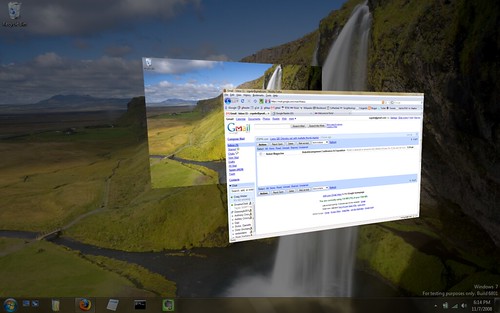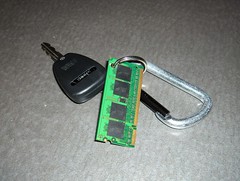The Windows 7 calculator is quite a bit more useful than the calculator in Vista or XP. If you've been wanting to give it a try and don't want to or can't install Windows 7, you can now install it under Vista. I've tested it, and it works very well. Link
Tuesday, November 11, 2008
Snowboarding and the art of Social Activity
This winter, several of my friends and I decided to get season passes to the local Ski resort. When my dad heard about this, he questioned it by saying, "I thought you didn't like snowboarding?" While this isn't completely accurate (I have never been snowboarding before), it got me thinking. How much of what we do is not about the activity itself, but rather the people we do it with? And, how often do people mildly affected by Asberger's syndrome (such as my father and I) miss this detail.
Most people have probably found themselves going to a movie or some other activity, not because they really wanted to see that movie, but because their friends we're going. I personally feel that I have missed this many times, and focused more on the activity than the people.
How do you think this affects the relationships of those who have mild Asberger's? Let everyone know in the comments.
Monday, November 10, 2008
Part 1: Building a Multi-Purpose Home Server
 Over the next 6 weeks, we'll be doing a series of posts on setting up a home server. The goal of this server is to be multi-purpose, reliable, and (most importantly) low budget. We will be covering each the following topics:
Over the next 6 weeks, we'll be doing a series of posts on setting up a home server. The goal of this server is to be multi-purpose, reliable, and (most importantly) low budget. We will be covering each the following topics:- Selecting & Building the Hardware
- Installing the OS
- Samba File Sharing
- Apache2 Web Server
- Subversion Version Control
- Hamachi
- 3.0GHz Pentium 4
- 2x 1GB DDR2 Ram
- Optical Drive (for installing software)
- 2x 500GB Hard Drives
- Supported Motherboard
- RAID card (optional)
That's it for this week. Coming up next Monday, we'll install Ubuntu 8.10 Server on our newly built hardware.
Free (as in speech) vs. Free (as in beer)

- Ubuntu
- openSUSE
- Mint
Friday, November 7, 2008
Windows 7: First Thoughts

A Netbook should not have a 15.4" screen. That's the first thing I thought when I stated using the HP Compaq 6715b with Windows 7 installed. It has a slow processor (1.6GHz Turion 64 x2), almost no RAM (1GB 667MHz), and a small Hard Drive (80GB 5400rpm). Essentially, it's an EEE PC with a big screen. The very thought of running Vista on it makes even the most dedicated Windows user shudder. Surprisingly though, Windows 7 is useable on it. For example, while I'm writing this (running Firefox 3.0, Evernote, Task Manager, and MS Word 2007) Windows is using 1% processor and 716MB RAM. Not bad considering a Vista system uses ~1.5GB right after boot up. Boot up also seems to be quite a bit faster than Vista.
The new super bar is currently my favorite feature. It allows you to pin program shortcuts right to the bar. If the program is not running, clicking the shortcut will start it. If the program is running, the shortcuts work to show/hide the window. If the program has more than one window open, hovering over the shortcut displays a preview of the windows, which you can then select.
The hardware detection worked great, probably a little better than Vista's. I was sure that the 6715b's touch controls for Wireless and Volume would not work out of the box, but surprisingly they do. So far the only thing hardware wise that I do not like is the 6715b's keyboard; the space bar only registers about half the presses. Other than that, it's great.
Post by: Craig Weber
PDC: No, Windows 7: Yes
Unfortunately, no one here could make it to PDC or WinHEC this year. So while we didn't get a nifty 160GB hard drive full of press kit materials, we did manage to get a hold of Windows 7 x64 build 6801. Over the next few weeks I'll be testing this build as thoroughly as possible, by completely replacing my normal Vista/Ubuntu laptop with a laptop running 7. General tasks will include web browsing (Firefox 3.0), photo-organizing (Adobe Lightroom 2.0), photo-editing (Adobe Photoshop CS3), programming (Eclipse), and writing (MS Word 2007). System specs follow; notice, as Windows 7 is supposed to use significantly fewer system resources, the Windows 7 laptop is much slower:
Vista Laptop (Dell Inspiron 1501)
- 1.6GHz Turion 64 x2
- 4GB 800MHz DDR2 RAM
- 160GB 5400RPM HDD
Windows 7 Laptop (HP Compac 6715b)
- 1.6GHz Turion 64 x2
- 1GB 677MHz DDR2 RAM
- 80GB 5400RPM HDD
Thursday, August 7, 2008
Speed, Features, and the Direction of Software Development
Many times, developing pretty software is the chosen path, as prettiness is something people can see. Therefore it tends to bring praise upon the developer. If one chooses to make 'pretty' software, users will initially be drawn to using it. However if it is overly slow, that appeal may not last longer than a few days.
Take for example Windows Vista. Without going into whether or not Vista is good software, two things can be said for certain. Vista is graphically pleasing. And, compared to less visually appealing operating systems, say XP, it runs slow. So, which operating system is doing better with the consumer? Without a doubt, XP.
The reason this is so pertinent now is because of several recent announcements coming from the open source community. Mark Shuttleworth's urging of the Linux desktop to be graphically better than OS X, and the Mozilla foundation's concept of Aurora. Both of these require extremely advanced technology, and would potentially be ultra-user friendly and flexible. But at what cost? In the case of Aurora, anything short of a modern day super computer would run the software so slowly that it would be simply unusable.
So, at least until the day when every person has several petaflops of computing power in their notebook, shouldn't the focus of developers be on creating software that 1) works flawlessly 2) is unbloated, fast, and responsive. While graphic design should be a priority, the first two listed should come first. In the long run, people will get used to software that doesn't look like Aurora. However software that runs as fast as a Snail on depressants will do nothing but anger users.
New RAM, Working Server
Thursday, July 31, 2008
New Server: Assembled; RAM not so good
Also, I think my two older IDE drives are bad, but that could be the RAM too.
Wednesday, July 23, 2008
My New Server- Hardware

My home network setup simply requires a server. On that server, I run Subversion, Samba, and Apache2 with Bugzilla, Media Wiki, and Subversion access. In the past I've use the latest Ubuntu Desktop release as the OS, running on an old Sony Vaio Workstation I had lying around. This worked fine until yesterday, when Sony's notoriously unreliable (1st Gen) hardware finally failed, leaving me serverless.
I'm still not entirely sure what went wrong; I haven't had time to investigate. But, I was able to order enough hardware to build a new server from the ground up. It isn't anything to high performance, a personal server doesn't need to be. But it should be significantly better than the seven-year-old Vaio. These are the specs:
- 3.0 GHz Pentium 4 CPU (Single Core)
- 2 New 500 GB 7200 RPM HDD's + 2 Old 120 GB 7200 RPM HDD's (Total of 1.24 TB storage!)
- 2 GB 667 MHz DDR2 Memory
- Gigabit Ethernet
- 10 Bay ATX Case with 9.8" Fan on Side (See picture above)





